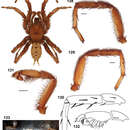Description
provided by Zookeys
Specimen preparation and condition. Specimen collected from burrow raised to maturity in captivity (matured 24.ix.74), preserved in 70% ethanol. Coloration faded. Pedipalp, leg I left side removed stored in vial with specimen, excuviae. General coloration. Carapace, chelicerae, dark red 2.5YR 3/6; legs strong brown 7.5YR 4/6. Abdomen uniform brown 7.5YR 4/4 dorsally; ventrally, spinnerets pale yellow. Cephalothorax. Carapace 5.88 long, 4.56 wide, with fine white setae, stout black bristles along fringe; surface smooth, pars cephalica slightly elevated. Fringe, posterior margin with black bristles. Foveal groove deep, recurved slightly. Eyes on low mound. AER slightly procurved, PER slightly recurved. PME, AME subequal diameter. Sternum moderately setose, STRl 3.09, STRw 2.49. Posterior sternal sigilla small, positioned towards margin, not contiguous, anterior sigilla pairs small, oval, at margins. Chelicerae with distinct anterior tooth row comprising 7 teeth, posterior margin with single row of small denticles. Palpal endites with patch of small cuspules on proximal, inner margin, labium lacks distinct cuspules, LBw 0.84, LBl 0.40. Rastellum consists of 5 very stout spines arranged along anterior margin, not on distinct mound. Abdomen. Setose, heavy black setae intermingled with fine black setae; light markings (Fig. 120). Legs. Leg I: 5.25, 3.63, 4.00, 2.49, 1.98; leg IV: 5.25, 2.90. Very light tarsal scopulae on legs I, II. Tarsus I with single, slightly staggered row of 15 trichobothria. Leg I spination pattern illustrated in Figures 128-130, metatarsal I mating apophysis knob shaped (Figs 128, 130; TSp 7, TSr 6, TSrd 1. Pedipalp. Articles relatively slender, lacking distinct spines (Figs 131, 132). PTw 0.74, PTl 2.19, Bl 1.10. Embolus slender, tapering gradually toward tip, lacking serrations (Fig. 131).
Variation. Males known only from the holotype specimen.
- bibliographic citation
- Bond J (2012) Phylogenetic treatment and taxonomic revision of the trapdoor spider genus Aptostichus Simon (Araneae, Mygalomorphae, Euctenizidae) ZooKeys 252: 1–209
- author
- Jason E. Bond
Distribution
provided by Zookeys
Known only from the type locality (Map 1), Mt. Diablo in the Black Hills, in Contra Costa County. The ecoregion comprises California coastal chaparral forest and shrub habitat.
- bibliographic citation
- Bond J (2012) Phylogenetic treatment and taxonomic revision of the trapdoor spider genus Aptostichus Simon (Araneae, Mygalomorphae, Euctenizidae) ZooKeys 252: 1–209
- author
- Jason E. Bond

